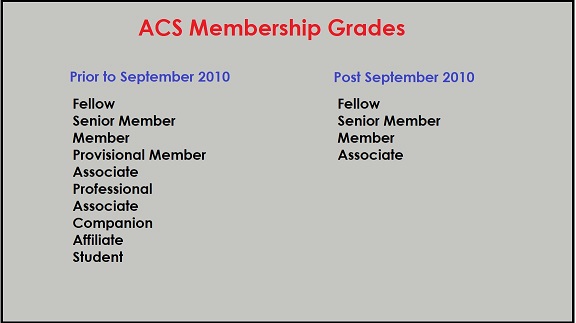Prior to 2010, ACS had nine membership grades: Fellow, Senior Member, Member, Provisional Member, Associate, Provisional Associate, Companion, Affiliate, and Student.
Prospective members of ACS were required to apply for a membership by completing a four-page form that captured education, experience and referees.
Applications would be assessed by an assessor and a grade of membership would be awarded.
ACS also ran two programs, called the Practising Computer Professional Program and the Certified Member Program as pathways for those without formal qualifications to become a Professional Member.
Successful candidates became MACS PCP and CMACS respectively.
On 13 September 2010, ACS launched its new Regulations and Membership Guidelines.
These regulations simplified the Membership structure from nine grades to four and made ACS Certification the pre-requisite to underpin Professional Membership.
The purpose of these changes was to open ACS membership to any person studying, working or working closely in ICT, and to provide Professional Membership to those completing the ACS Certified Professional or Certified Technologist applications.
The changes came live on the 13 September 2010 in time for a formal launch at the World Computer Congress in Brisbane later that month.
The 2010 introduction of open membership included transition arrangements where a large cohort of long-term Associate members were grandfathered to Member of ACS holding Certified Technology (MACS CT), as well as a campaign encouraging existing Associate members to be certified for free, ending on 31 December 2010.
The transition arrangements of 2010 saw a surge in professional membership peaking at 12,737 in October 2010 – a 20%+ increase on the January 2010 number of professional graded members.

Since that time there has been a steady decline in professional members which was understood and planned for.
There are three reasons for this:
1. Since 1 January 2011, unless applying new members also select a certification assessment that attracts an additional fee, all new members join ACS at Associate level. If they choose not to be assessed for a certification upon application, they can choose to do so at any future time.
2. For grandfathered long-time members, certification was not a driving factor for becoming members of ACS. With the introduction of mandatory Continuing Professional Development (CPD) hours, half of grandfathered Certified Professionals dropped off after the first twelve months, thereby losing their certification.
3. Professional standards evolve over time, and as professions mature, benchmarks also raise over time. ACS’ assessment processes in turn introduce more rigour to ensure those demonstrating professional benchmarks can be trusted and have the skills and knowledge to provide independent expertise.
It is through this process that ACS has been able to achieve an ACS Professional Standards Scheme with the Professional Standards Council that caps professional indemnity for those eligible ACS members who are participating in the Scheme.
At the end of 2014, ACS became the first professional society to be accredited by IP3 for the Certified Technologist (CT) program.
Up until this point of time, CT was being awarded to all students who completed an ACS accredited degree.
To be consistent with the ISO/IEC 17024 standard and achieve IP3 accreditation, an experience requirement of twelve months was introduced to the CT program for members completing an accredited ACS degree which, while lifting standards, also had the effect of halving CT numbers of ACS members by May 2015.









